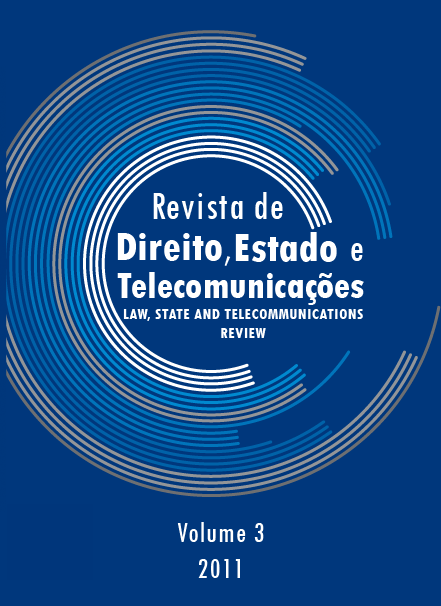The Brazilian Video Marketplace: A Regulatory Analysis and Perspective under the US Law
DOI:
https://doi.org/10.26512/lstr.v3i1.21669Keywords:
electronic content, telecommunications service, content control, Internet, Brazil, United StatesAbstract
This work investigates the arising regulatory framework of electronic content distribution within the Brazilian Telecommunications Industry. The article describes the current stage of the convergence revolution in the world from diverse perspectives and how the rigidity of the classical definitions and the regulatory framework of traditional telecommunications services have delayed and even endangered the advance of convergence tools in Brazil. In the context of the convergence revolution, special attention is paid to disputes between Brazilian broadcasters and Internet-based content providers and how the emerging legislation will affect them. Finally, from the current status questionis of the debate in Brazil, the paper analyzes the proposals and consequences of the electronic content control regulations in the country. This article constantly compares the Brazilian regulatory background with that of the United States for referential and critical analysis purposes.
Downloads
References
BARRON, J. A. (1973). Freedom of the Press for Whom? Right of Access to Mass Media. Bloomington: Indiana University Press.
BARRON, J. A.; DIENES, T. C. (2001). Constitutional Law. St. Paul: West Group.
BENJAMIN, S. M. [et al.] (2006). Telecommunications Law and Policy. Durham, NC: Carolina Academic Press.
BRANDS, H.; LEO, E. T. (1999). The Law and Regulation of Telecommunications Carriers. London: Artech House.
CARTER, T. B.; DEE, J. L.; ZUCKMAN, H. L. (2000). Mass Communications Law. St. Paul: West Group.
CARVALHO, A. A. [et al.]. (2003). Direito da comunicação social. Lisboa: Notícias Editorial.
CASTELLS, M. (2007). A sociedade em rede. A era da informação: economia, sociedade e cultura. São Paulo: Paz e Terra.
CORDOVIL, L. A. G. (2005). A intervenção estatal nas telecomunicações: a visão do direito econômico. Belo Horizonte: Fórum.
DUESTERBERG, T; GORDON, K. (1997). Competition and Regulation in Telecommunications: The Case for a New Paradigm. Indianapolis: Hudson Institute.
FANG, I. (1997). History of Mass Communication: Six Information Revolutions. Boston: Focal Press.
FARRELL, J. [et al.]. (2003). Modularity, Vertical Integration and Open Access Policies: Towards a Convergence of Antitrust and Regulation in the Internet Age. In: Harvard Journal of Law & Technology 17(1): 86-134.
FAULHABER, G. R. (2005). Bottlenecks and Bandwagons: Access Policy in the New Telecommunications. In: Handbook of Telecommunications and Economics: Technology Evolution and the Internet. Amsterdam: Elsevier North-Holland.
GRANT, A. [et al.]. (2009). Understanding Media Convergence: The State of the Field. New York: Oxford University Press.
GREENSTEIN, S.; KHANNA, T. (1997). What Does Industry Convergence Means? In: Competing in the Age of Digital Convergence. Boston, MA: Harvard Business School Press.
HALLIN, D.; MANCINI, P. (2006). Comparing Media Systems: Three Models of Media and Politics. New York: Cambridge University Press.
JENKINS, H. (2006). Convergence Culture: Where Old and New Media Collide. New York: New York University Press.
JUSTEN FILHO, Marçal. (2002). O direito das agências reguladoras independentes. São Paulo: Dialética.
KATZ, M. [et al.]. (1985). Network Externalities, Competition and Compatibility. In: Am. Econ. Rev. 75: 424.
KENNEDY, Charles H. (2001). An Introduction to US Telecommunications Law. 2ª ed., Norwood, MA: Artech House.
KNUTSEN, Eric. (2001). Techno-Neutrality of the Freedom of Expression in New Media Beyond Internet: Solutions for the United States and Canada. In: UCLA Entertainment Law Review 8(2).
KÜNG, L. [et al.]. (2008). The Internet and the Mass Media. Thousand Oaks, CA: Sage Publications.
LAWSON-BORDERS, Gracie. (2005). Media Organizations and Convergence. Routhledge.
LEMLEY, M. (2007). The End-to-End: Preserving the Architecture of the Internet in the Broadband Era. Working Paper 207, Stanford Law School.
LEVY, Jonathan D.; PITSCH, Peter. (1985). Statistical Evidence of Substitutability Among Video Delivery Systems in Video Medias Competition, Regulations, Economics, and Technology. New York: Columbia University Press.
LOETZ, S.; KOENIG, C. Framework for Network Access and Interconnection. In: KOENIG, C. [et. al.]. (2002). EC Competition and Telecommunications Law. Hague: Kluwer Law International.
LOPES, V. M. de O. N. (1997). O direito à informação e as concessões de rádio e televisão. São Paulo: Revista dos Tribunais.
MITCHELL, William. (2006). The Needle and the Damage Done: The Pervasive Presence of Obsolete Mass Media Audience Models in First Amendment Doctrine. Working Paper 62, p. 49. Vide: http://papers.ssrn.com/sol3/papers.cfm?abstract_id=945662.
NEWTON, H. (2002). Newton’s Telecom Dictionary. 18ª ed., New York: COM Books.
NIHOUL, P.; RODFORD, P. (2004). EU Electronic Communications Law: Competition and Regulation in the European Telecommunications Market. New York: Oxford University Press.
PEREIRA, C. F. de O. (ed.). (2003). O novo direito administratio brasileiro: o Estado, as agências e o terceiro setor. Belo Horizonte: Fórum.
POOL, I. de S. (1983). Technologies of Freedom: On Free Speech on an Electronic Age. Cambridge, MA: Harvard University Press.
PRADO, Paola. (2008). Foreign Ownership of Broadcast Television Stations in the Digital Era. Artigo apresentado no National Communications Association realizado em San Diego, p. 2. Vide: http://www.allacademic.com//meta/p_mla_apa_research_citation/2/5/8/8/0/pages258802/p258802-1.php.
SHEPERD, Steven. (2002). Telecommunications Convergence: How to Bridge the Gap Between Technologies and Services. New York: McGraw-Hill Companies.
SMITH, F. L. (1995). Electronic Media and Government: The Regulation of Wireless and Wired Mass Communication in the United States. White Plains, NY: Longman Publisher.
SPARROW, A. (2004). The Law of Internet and Mobile Communications: The EU and US Contrasted: Malta: Gutenberg Press.
SUNSTEIN, Cass. (1995). The First Amendment in Cyberspace. In: Yale Law Journal 104: 1757.
TEETER, Dwight L. [et al.]. (2008). Law of Mass Communications: Freedom and Control of Print and Broadcast Media. New York: Foundation Press.
USTRA, Carlos Alberto Brilhante. (2007). A verdade sufocada. 5ª ed., Brasília: Editora Ser.
WALDEN, Ian (ed.). (2009). Telecommunications Law and Regulation. 3ed., Oxford: Oxford University Press.
WU, Tim. (2003). Network Neutrality, Broadband Discrimination. In: Journal of Telecommunications and High Technology Law 2: 141.
YOFFIE, David B. (1997). Competing in the Age of Digital Convergence. Boston: Harvard Business School Press.
Downloads
Published
How to Cite
Issue
Section
License
By submitting this paper to the Law, State and Telecommunications Review,
I hereby declare that I agree to the terms of the Creative Commons Attribution 4.0 International (CC BY 4.0).


